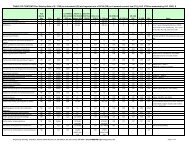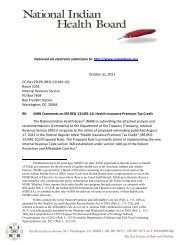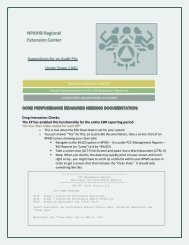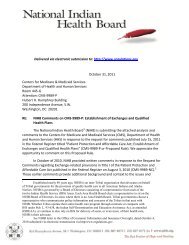mmpc - National Indian Health Board
mmpc - National Indian Health Board
mmpc - National Indian Health Board
You also want an ePaper? Increase the reach of your titles
YUMPU automatically turns print PDFs into web optimized ePapers that Google loves.
Age and Sex<br />
Methods<br />
Medical care payments increase with age, and yet the differences in age of populations among AIAN<br />
groups and between AIAN and Whites cannot be changed unless a Medicaid eligibility policy change<br />
occurs affecting age groups differently. Age can be coded continuously (in years), or in intervals (5<br />
or 10 year age cohorts). Usually an analytical definition is used to avoid unnecessarily large<br />
numbers of interval groups: irregular intervals are used to define age groups with substantially<br />
higher payments than the immediate younger group. We will test the use of a Continuous Age<br />
variable and an analytical Interval Age Group variable. The adjustment that explains most of the<br />
variation in the Mean Total Payment will be used in the Core Model.<br />
Medical care payments are generally higher for women than men when the services include<br />
reproductive care, and especially higher in Medicaid for women who are pregnant or give birth<br />
during the year. Alternatives for gender determinants are 1) Male, Female pregnant, & Female non-<br />
Pregnant; or 2) Male, Female, with adjustment for pregnancy and childbirth services in the Service<br />
Coverage variables. The adjustment that explains most of the variation in the Mean Total Payment<br />
will be used in the Core Model.<br />
Disability as Basis of Medicaid Eligibility and Dual Eligibility with Medicare<br />
Medical care payments are generally higher for blind or disabled individuals. We provided a list of<br />
the blind and disabled eligibility categories for Medicaid and for Dual Eligibility with Medicare in<br />
AIAN Medicaid Program and Policy Statistics: Summary Report, 2009 . The proportions of AIAN<br />
Medicaid eligibles who are Disabled or Dual eligibles in each IHS Area are documented in AIAN<br />
Medicaid Program and Policy Data, 2010 .<br />
Risk Adjustment: Morbidity<br />
Medical care costs rise as the number and severity of medical conditions increase. To determine if<br />
there are differences in payments not related to illness requires adjusting costs for differences in the<br />
morbidity burden among the study groups. This is possible with Medicaid claims tested Risk<br />
Adjustment software systems (Winkelman and Dammler, 2008). We used the Adjusted Clinical<br />
Groups® (ACG) system developed at The Johns Hopkins University to characterize the concurrent<br />
morbidity burden in the AIAN and White Medicaid populations in our study for the time period of<br />
the claims (http://www.acg.jhsph.org). With this software demographic, diagnostic and procedure<br />
code combinations on 12 continuous months of claims and encounter records were reduced to a<br />
fixed number of health status categories called Aggregated Diagnosis Groups.<br />
The ACG system captures interrelationships between co-occurring morbidities that pose the greatest<br />
demands for health care resources. ACG actuarial cells are based on Aggregated Diagnosis Groups<br />
that are similar in terms of severity and likelihood of persistence of the health condition over time.<br />
Diagnostic codes are assigned to one of the 32 clusters of Aggregated Diagnosis Groups. Since<br />
individuals can have more than one diagnosis, they may have more than one Aggregated Diagnosis<br />
Group. Individual diseases or conditions are placed into a single Aggregated Diagnosis Groups based<br />
14










